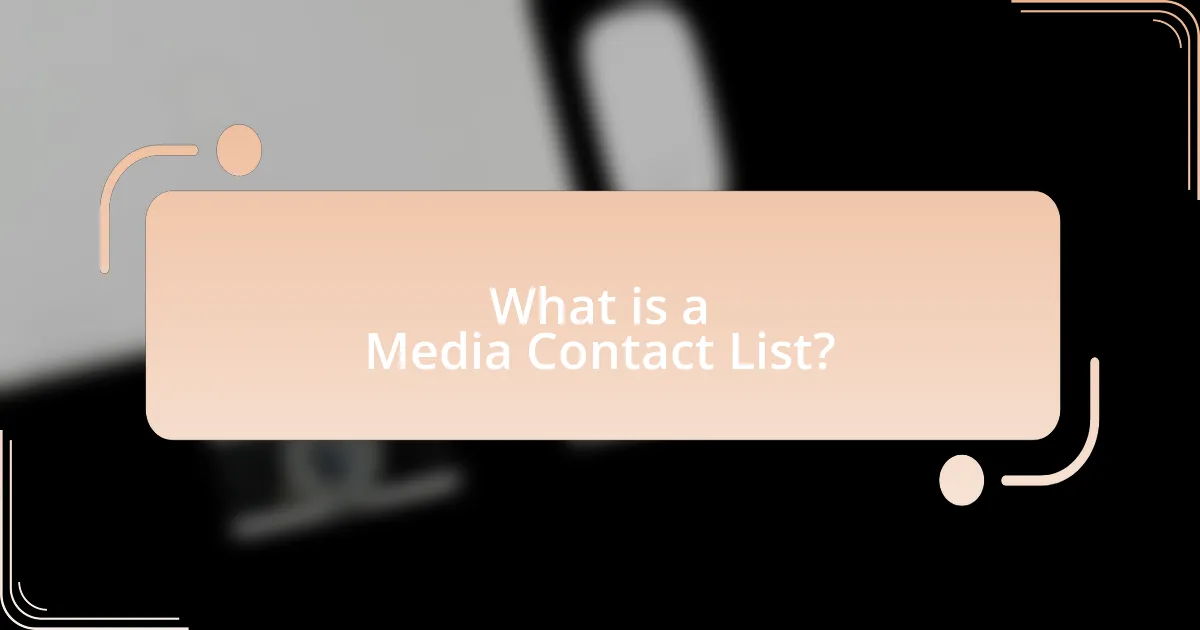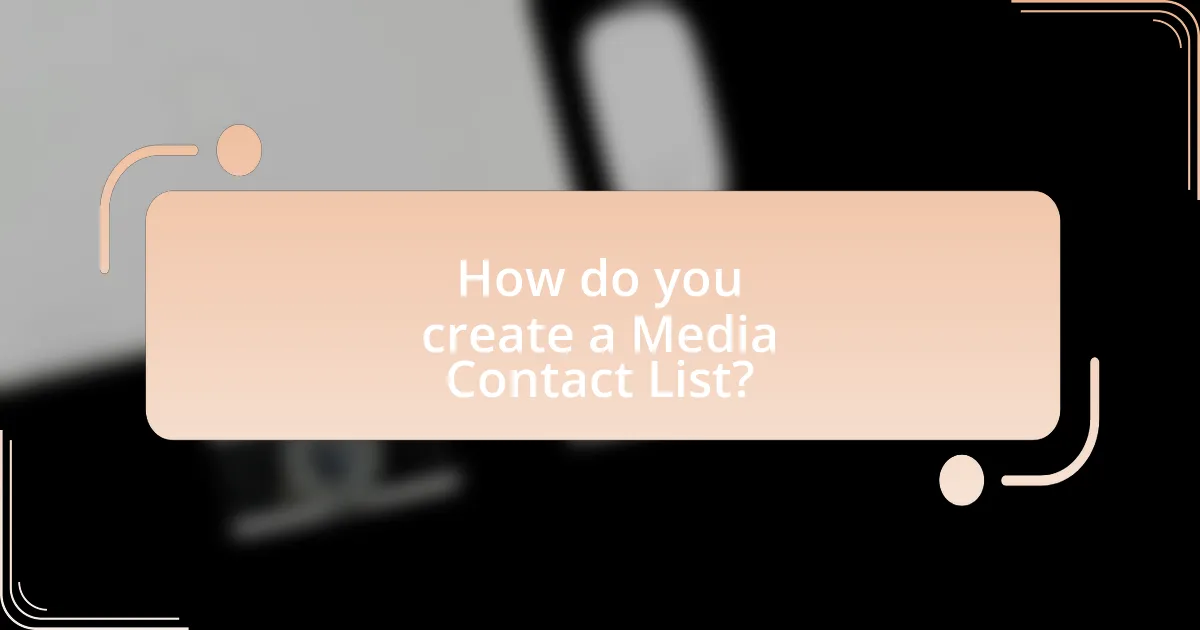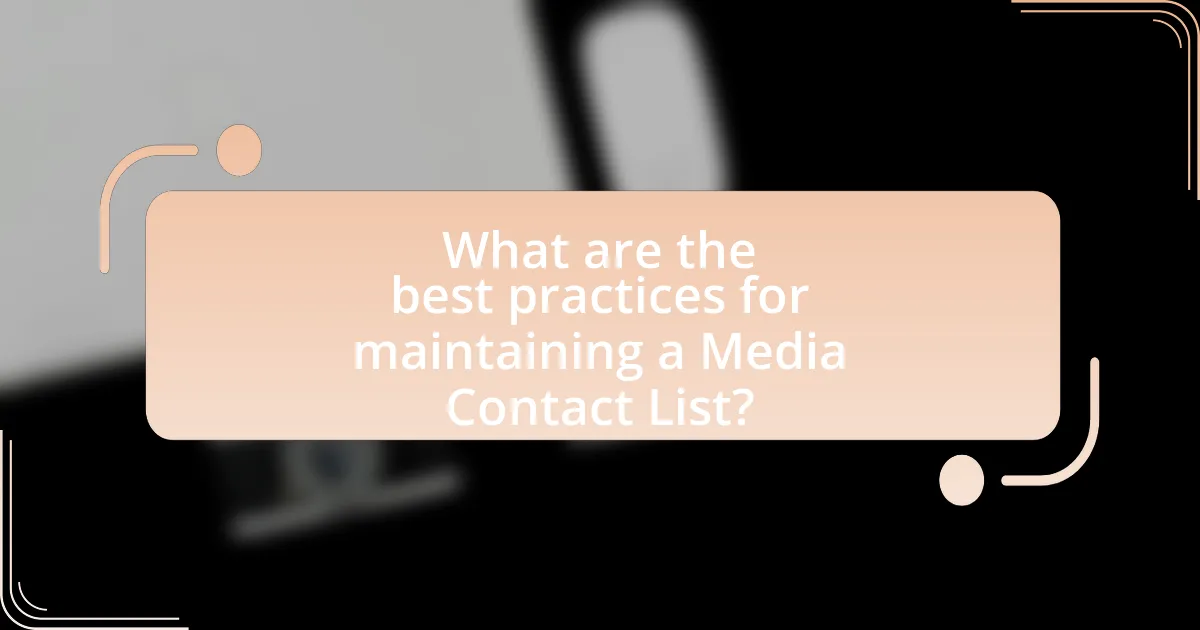A Media Contact List is a vital tool for organizations, comprising a curated collection of journalists, editors, and media professionals along with their contact details. This article outlines the significance of a Media Contact List in public relations, emphasizing its role in enhancing communication, increasing media coverage, and building relationships with key media personnel. It details the essential components of an effective list, methods for creating and maintaining it, and best practices for ensuring accuracy and relevance. Additionally, the article highlights the importance of personalization and segmentation in outreach efforts to improve engagement and brand visibility.

What is a Media Contact List?
A Media Contact List is a curated compilation of journalists, editors, and media professionals along with their contact information, used by organizations to facilitate communication and outreach. This list typically includes details such as names, email addresses, phone numbers, and the specific media outlets they represent, enabling targeted distribution of press releases and news updates. The effectiveness of a Media Contact List is supported by its ability to enhance public relations efforts, as research indicates that personalized outreach can significantly increase media coverage and engagement.
How does a Media Contact List function in public relations?
A Media Contact List functions in public relations by serving as a curated database of journalists, editors, and media outlets relevant to a specific organization or industry. This list enables public relations professionals to efficiently distribute press releases, pitch story ideas, and foster relationships with key media personnel. By organizing contacts based on factors such as beat, publication type, and audience reach, PR practitioners can tailor their communications to ensure maximum impact and relevance. The effectiveness of a Media Contact List is evidenced by its ability to increase media coverage and enhance brand visibility, as targeted outreach often leads to higher engagement rates and more favorable media placements.
What are the key components of an effective Media Contact List?
An effective Media Contact List includes accurate contact information, relevant media outlets, and specific journalist details. Accurate contact information ensures that communications reach the intended recipients, while relevant media outlets align with the target audience and industry. Specific journalist details, such as their beat and past articles, help tailor pitches to their interests, increasing the likelihood of coverage. Research indicates that personalized outreach, based on these components, significantly enhances engagement rates with media professionals.
How does the accuracy of contact information impact outreach?
The accuracy of contact information significantly impacts outreach by ensuring that communications reach the intended recipients. When contact details are precise, the likelihood of engagement increases, as messages are delivered to the correct individuals, thereby enhancing response rates. For instance, a study by HubSpot found that personalized emails, which rely on accurate contact data, have a 29% higher open rate compared to generic messages. Inaccurate information, on the other hand, leads to wasted resources and missed opportunities, as outreach efforts may fail to connect with key media contacts. Thus, maintaining accurate contact information is crucial for effective outreach strategies.
Why is a Media Contact List important for businesses?
A Media Contact List is important for businesses because it facilitates effective communication with journalists and media outlets, enhancing public relations efforts. By having a curated list of relevant media contacts, businesses can ensure that their press releases and newsworthy information reach the right audience, increasing the likelihood of media coverage. Research indicates that targeted outreach can improve response rates by up to 50%, demonstrating the value of a well-maintained media contact list in maximizing visibility and engagement.
What role does it play in building media relationships?
Building a media contact list plays a crucial role in establishing and nurturing media relationships. A well-curated list enables effective communication with journalists and media outlets, facilitating targeted outreach and personalized engagement. This targeted approach increases the likelihood of media coverage, as journalists are more receptive to pitches that align with their interests and beats. Research indicates that personalized communication can improve response rates by up to 50%, demonstrating the effectiveness of a strategic media contact list in fostering strong relationships.
How can it enhance brand visibility and reputation?
Building a media contact list enhances brand visibility and reputation by facilitating targeted outreach to journalists and influencers who can amplify brand messages. This targeted communication increases the likelihood of media coverage, which can reach wider audiences and establish credibility. For instance, brands that engage with relevant media outlets often see a 30% increase in brand recognition, as reported by the Public Relations Society of America. By consistently sharing newsworthy content with the right contacts, brands can cultivate a positive public image and foster trust among consumers.

How do you create a Media Contact List?
To create a Media Contact List, first identify your target media outlets and journalists relevant to your industry or niche. Next, gather contact information such as names, email addresses, phone numbers, and social media handles from reliable sources like media directories, LinkedIn, or the websites of the media outlets. Organize this information in a spreadsheet or database for easy access and updates. Regularly review and update the list to ensure accuracy and relevance, as media contacts can change frequently. This methodical approach ensures that your Media Contact List remains effective for outreach and communication.
What steps are involved in compiling a Media Contact List?
Compiling a Media Contact List involves several key steps. First, identify the target media outlets relevant to your industry or message, including newspapers, magazines, blogs, and broadcast stations. Next, gather contact information for journalists, editors, and influencers at these outlets, which can be sourced from their official websites, social media profiles, or media databases. After collecting the data, organize it into a structured format, such as a spreadsheet, ensuring to include names, titles, email addresses, phone numbers, and any specific areas of interest or expertise. Finally, regularly update the list to maintain accuracy and relevance, as media personnel frequently change roles or outlets. This systematic approach ensures that your Media Contact List is effective and useful for outreach efforts.
How do you identify the right media contacts for your industry?
To identify the right media contacts for your industry, start by researching industry-specific publications and journalists who cover relevant topics. Utilize tools like Cision or Muck Rack to find journalists’ contact information and their recent articles, ensuring they align with your niche. For example, if you are in the technology sector, look for journalists who write about tech innovations and trends. This targeted approach increases the likelihood of your outreach being effective, as studies show that personalized pitches to relevant contacts yield higher response rates.
What tools can assist in gathering contact information?
Tools that can assist in gathering contact information include LinkedIn, Hunter.io, and ZoomInfo. LinkedIn allows users to connect with professionals and access their contact details, while Hunter.io specializes in finding and verifying email addresses associated with specific domains. ZoomInfo provides a comprehensive database of business contacts, including direct phone numbers and emails, which can be filtered by industry and company size. These tools are widely used in media outreach and networking, making them effective for building a media contact list.
How can you organize your Media Contact List effectively?
To organize your Media Contact List effectively, categorize contacts by relevant criteria such as media type, geographic location, and audience demographics. This structured approach allows for targeted communication and enhances the likelihood of engagement. For instance, grouping journalists by their specific beats—such as technology, health, or finance—enables tailored pitches that resonate with their interests, increasing the chances of coverage. Additionally, maintaining updated contact information and regularly reviewing the list ensures that it remains relevant and useful, as outdated contacts can hinder outreach efforts.
What categories should you include in your list?
You should include categories such as media outlet type, contact name, email address, phone number, publication frequency, audience demographics, and social media handles in your media contact list. These categories ensure comprehensive coverage of essential information needed for effective outreach. For instance, categorizing by media outlet type (e.g., print, online, broadcast) allows for targeted communication strategies tailored to each medium’s characteristics. Additionally, including audience demographics helps in understanding the reach and influence of each contact, which is crucial for crafting relevant pitches.
How can segmentation improve your outreach efforts?
Segmentation can significantly enhance outreach efforts by allowing targeted communication tailored to specific audience groups. By dividing a broader audience into smaller, more defined segments based on characteristics such as demographics, interests, or behaviors, organizations can craft personalized messages that resonate more effectively. Research indicates that segmented email campaigns can lead to a 14.31% higher open rate compared to non-segmented campaigns, demonstrating the tangible benefits of this approach. This targeted strategy not only increases engagement but also improves conversion rates, as recipients are more likely to respond positively to content that aligns with their specific needs and preferences.

What are the best practices for maintaining a Media Contact List?
The best practices for maintaining a Media Contact List include regularly updating contact information, segmenting contacts based on relevance, and personalizing communication. Regular updates ensure that the list reflects current details, as media contacts frequently change roles or organizations. Segmenting contacts allows for targeted outreach, improving engagement rates; for instance, categorizing by industry or media type can enhance the effectiveness of press releases. Personalizing communication fosters stronger relationships, as tailored messages resonate more with recipients. These practices are supported by industry standards, which emphasize the importance of accuracy and relevance in media relations for successful outreach campaigns.
How often should you update your Media Contact List?
You should update your Media Contact List at least every six months. Regular updates ensure that you have the most current contact information, as media personnel frequently change roles or organizations. According to a study by Cision, 70% of journalists change jobs within a year, highlighting the importance of maintaining an accurate list to effectively reach your target audience.
What methods can you use to verify contact information regularly?
To verify contact information regularly, utilize methods such as automated email verification tools, periodic outreach, and data enrichment services. Automated email verification tools, like NeverBounce or ZeroBounce, can check the validity of email addresses in real-time, ensuring that your contact list remains accurate. Periodic outreach involves sending updates or newsletters to contacts, prompting them to confirm their information, which helps maintain current data. Data enrichment services, such as Clearbit or ZoomInfo, can provide updated information by cross-referencing existing data with reliable databases, enhancing the accuracy of your contact list. These methods collectively ensure that the contact information remains reliable and up-to-date.
How can you track interactions with media contacts?
To track interactions with media contacts, utilize a Customer Relationship Management (CRM) system designed for public relations. These systems allow users to log communications, categorize contacts, and analyze engagement metrics. For instance, platforms like Cision or Meltwater provide tools to record emails, phone calls, and meetings, enabling users to maintain a comprehensive history of interactions. This method ensures that all communication is documented, making it easier to follow up and assess the effectiveness of outreach efforts.
What common mistakes should you avoid when building a Media Contact List?
Common mistakes to avoid when building a Media Contact List include failing to research contacts thoroughly, which can lead to irrelevant outreach. Many individuals neglect to verify the accuracy of contact information, resulting in wasted efforts on outdated or incorrect details. Additionally, not segmenting the list based on media type or audience can hinder targeted communication, reducing the effectiveness of outreach campaigns. Another mistake is not personalizing messages, as generic communications are less likely to engage journalists. Lastly, overlooking the importance of maintaining and updating the list regularly can lead to a decline in its relevance and utility over time.
How can inaccurate information hinder your media outreach?
Inaccurate information can significantly hinder media outreach by damaging credibility and trust with journalists and media outlets. When outreach efforts are based on false or misleading data, it can lead to negative coverage, rejection of press releases, and a damaged reputation. For instance, a study by the Pew Research Center found that 63% of journalists consider accuracy as the most important factor when evaluating press materials. If the information provided is incorrect, it undermines the relationship with media professionals and reduces the likelihood of future engagement.
What are the risks of not segmenting your contacts?
Not segmenting your contacts can lead to ineffective communication and reduced engagement. When contacts are not categorized based on their interests or demographics, messages may become irrelevant, resulting in lower open and response rates. For instance, a study by HubSpot found that segmented email campaigns can lead to a 760% increase in revenue compared to non-segmented campaigns. Additionally, failing to segment can cause increased unsubscribe rates, as recipients may feel overwhelmed by generic content that does not address their specific needs or preferences. This lack of targeted messaging ultimately diminishes the effectiveness of outreach efforts and can harm relationships with key contacts.
What tips can enhance the effectiveness of your Media Contact List?
To enhance the effectiveness of your Media Contact List, ensure it is regularly updated and segmented based on specific criteria such as industry, audience, and type of media outlet. Regular updates maintain accuracy, as media personnel frequently change roles, and segmentation allows for targeted communication, increasing the likelihood of engagement. Research indicates that personalized outreach can improve response rates by up to 50%, demonstrating the importance of tailoring your approach to different segments within your list.
How can personalization improve your communication with media contacts?
Personalization enhances communication with media contacts by fostering stronger relationships and increasing engagement. Tailoring messages to the specific interests and preferences of media contacts demonstrates an understanding of their work, which can lead to more meaningful interactions. Research indicates that personalized outreach can result in a 29% higher open rate for emails, as recipients are more likely to respond to content that resonates with their individual needs and interests. By addressing media contacts by name and referencing their previous work or interests, communicators can create a more compelling narrative that captures attention and encourages collaboration.
What strategies can help you engage with media contacts more effectively?
To engage with media contacts more effectively, prioritize personalized communication tailored to each contact’s interests and needs. This approach fosters stronger relationships and increases the likelihood of positive media coverage. Research indicates that personalized outreach can improve response rates by up to 50%, as media professionals appreciate when their specific preferences are acknowledged. Additionally, maintaining regular follow-ups and providing valuable content, such as exclusive insights or data, can further enhance engagement and establish credibility.